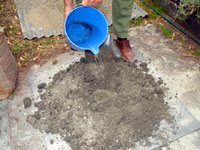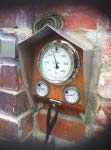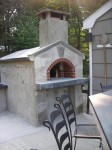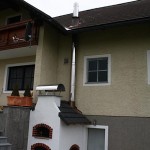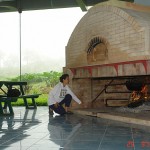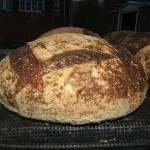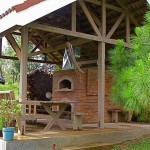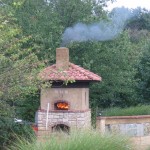Refractory Concrete Tutorial - Recipe and Instructions
Mixing heat resistant mortar without a concrete mixer
Mix recipe and ingredients of refractory concrete. Mixing your heat resistant concrete by hand with pictures.
Heat resistant refractory concrete
There are two ways; two types of heat resistant concretes that can be prepared. Cheaper and more expensive - stronger and weaker under a heat. The first one is the high heat refractory concrete. This type will survive in real high heat and can be used for hot-face applications
What is hot face?
Hot face is any surface facing the main heat generated by a heat source (e.g. wood fire, gas burner, electrical heating spiral & other heat producing elements.) Internal walls, floor and arches made from firebricks inside a pizza oven is hot-face. Firebricks face the heat, the hot flames from wood fire and the red hot embers. Refractory concrete can face the heat therefore applied as a hot face.
Refractory or heat resistant concrete may be mixed with heat resistant cement, or, can be purchased ready in bags as pre-mix product. The packed one is most often referred to as castable.
But saying that, even though it's refractory, still it is not so straight forward to cast large hot face section/s out of it. It is different to fill holes and awkward spaces with castables. Large blocks tend to crack as a result of something called heat differences in material, or temperature differences in material in other words, which is a very powerful natural phenomena. But hey no worries Mate, we still have firebricks here luckily (firebricks those nice little fragments) for making the dome part properly (read more about heat differences in materials - basically it deals with shrinking of cooled down edges and also surfaces while middle is still hot and expanded).
A wise idea is to mix the heat resistant cement, e.g. Calcium Aluminate cement, with firebrick grog. The grog comes basically from crushed firebrick/s. Companies who manufacture refractory material (like Claypave Pty. Ltd. in Dinmore, Qld. Au.), or those who only resell firebricks, usually sell also firebrick grog, ready premixed refractory mortars and fireclay. There are many different refractory cement types, some of them allowed to mixed in lime, plaster, or fireclay, but others cannot be mixed with these because their chemical properties don't allow it, rather they get contaminated by similar additives. Because they differ, read the usage instruction printed on a particular cement bag, also its producer will gladly give you print out on -it will tell you exactly how to or what can be done.
Now, the second one heat resistant concrete type. It is a lower grade heat resisting concrete, lower grade in withstanding heat but still it can be applied successfully in many areas whose get pretty heated too. For instance layers such as those on the other side of firebricks, on the outside of firebricks, the slab under the heated floor made from fire bricks or cladding around the firebrick dome, chimney parts, etc.
Into this concrete type the common Portland cement goes in (the Portland is often also referred to as GP cement and this type is already a bit refractory) and of course lime. Both lime and Portland are bonding agents and are described more further below. Instead of firebrick grog you can use river sand and river stones. Sand and stones that come from river. If buying it, it's easily recognizable; what comes from river is round and it isn't sharp as opposed to the mostly crushed stuff coming to us from stone quarries, otherwise either of them is a building material.
With a help of a few extra hands (plus hydrating liquids and nutritional energy of your choice ... "would you like to know what's my pick?") you can mix either of these concretes by hand in a wheelbarrow or on the ground because in smaller jobs, such as family sized pizza ovens, not much of it goes in. See the following sequence with images.
Heat-resistant concrete ingredients & the mixing formula:
Firebrick Grog (crushed fire bricks) or gravel from river with sand
Refractory cement (e.g. Calcium Aluminate cement. If available in different grades choose the better one)
Lime (lime is usually cheaper, about 80% of the cement price. Lime applies if you use Portland cement type)
Water
With the heat resistant concrete type mixed with Portland you can add into this mix a little standard Fireclay if you like.
Mixture: (parts ratio is 3 x 2 x 2 x 0.5, plus water)
3 shovels of the gravel or grog/crushed firebricks
2 shovels of sand (Portland concrete type only)
2 shovels of the cement
1/2 shovel of lime (for Portland concrete type)
This amount will require approximately 6-7 liters of water to mix the concrete.
Ingredients in the nowadays Portland cement are:
60% to 67% CaO
17% to 25% SiO2
3% to 8% Al2O3
up to 6% Fe2O3
plus can contain also mini amount of MgO, MgSO4, Na2O, and K2O
What sort of lime is it? Hydrated Lime?
Yes it's hydrated lime, Calcium hydroxide, commonly sold in shops in bags. Calcium hydroxide is chemical compound with the chemical formula Ca(OH)2 or traditionally called; Slaked lime, pickling lime but most often by builders as the Hydrated lime.

Refractory concrete dry ingredients
Put dry gravel and sand on a thin metal or plastic sheet, or on a clean concrete surface in an area you can make a bit dirty. (Be sure to clean the area and tools with water after working with cement.)
Add the cement and lime on top of the gravel and sand.
Calcium Aluminate cement and Lime will work the best as the cement in hot cooking conditions- This applies to refractory concrete as well as to heat resistant mortars.
(Lime is sometimes mixed into fire clays. This is mixed like a normal cement based mortar, but with half the cement replaced with the lime. The cement holds it together when it is drying but when the heat gets into the cement and burns it out, the lime holds it all together. Lime used in building - calcium hydroxide Ca(OH)2 [oxide of calcium CaO of limestone] is used for making mortar and cement.)
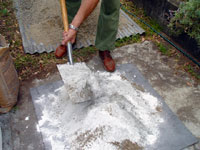
Mixing dry refractory concrete ingredients
Before adding water, mix all dry ingredients together well with a shovel by taking from the bottom and placing every shovel on the top until the mixture turns to a uniform color.
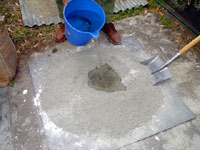
Adding water to refractory concrete
Create a hole in the middle and pour in about 2 liters of water. Continue mixing with a shovel as you did with the dry ingredients. The mix will become semi dry.
Add another couple of liters of water and mix it again the same way.
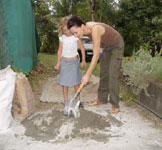
Adding more water to refractory concrete
It's good exercise, but it doesn't take too long before you start to notice the concrete becoming workable. If it's still too dry, add just a bit of water, but not too much at this stage because the consistency can change suddenly. If you add too much, don't worry; add more dry ingredients in the same ratio and just mix it in. The mixing could be done by anyone. (read about correct water addition at the bottom the page)
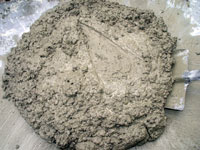
Refractory concrete of good consistency
Mixing the refractory concrete this way, without a concrete mixer machine, is not a very hard job. It's good fun and I find it easier than mixing the pizza dough. A single dome for a wood burning oven takes about 0.5 cubic meter of gravel - it's a small job, and it is interesting/enjoyable work.
The right consistency is achieved when you stop seeing dry patches in the mixture, and when not too much water is showing or preventing the concrete from keeping its shape on the ground as if it was kind of standing rather up than flowing. When you pile it up with the shovel it should sit, stay high and hold together.
For example, the correct consistency is achieved when a handful of concrete can be formed into a ball the size of a tennis ball and be tossed half a meter up into the air and then caught as a mass that stays together. You can easily test it for your selves. If it's too wet or too dry you will be able to tell.
Complete Wood burning oven building tutorial with 370+ photo series
A bit about 'refractory concrete' curing - drying.
The following information is important to ensure correct concrete curing. After an initial concrete set, cover your work with plastic sheeting and spray it with a fine spray of water to prevent rapid loss of water on edges and the surface.* For the first 24 hours, drying should be slow. After 24 hours, remove coverings and let air dry without strong sun for 48 hours.
It depends on the weather, but complete drying can take up to 3 weeks if it's cold outside. Start with short, small fires in the oven for the first time. Increase temperature gradually not quickly. If there is any remaining water in the dome walls, heat could change it to a steam and crack the wall. With a small fire you will help to drag that remaining water out.
Enjoy, Rado.
* While concreting; do not apply water by spraying it over the concrete surface to smooth it with trowel or leveling tool at the end. Your concrete block would lack the hard finish on the outside surface, or you could experience little stones on the bottom of your pizza and between your teeth for a while until you pick them all up. Compared to fire bricks, refractory concrete hearths may develop peeling problems and cracks down the track. Like with our Earth Globe and its tectonic plates - they/bricks are actually a large segments, if some part can not freely move therefore adjust in place a crack gets naturally created as a remedy. In regards to the expansion on heating and backwards contraction on cooling down movements in dome, we are talking only about a couple of millimeters or less. Brick domes consists of many small segments-bricks, they create nice and natural movement in the structure.
by Rado Hand
